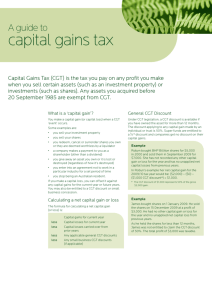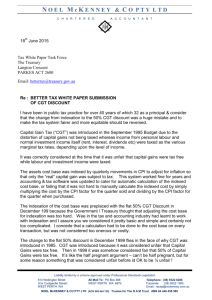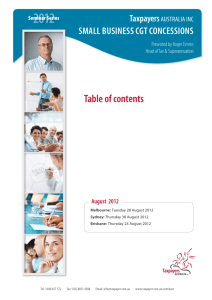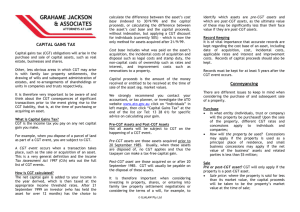CAPITAL GAIN OR CAPITAL LOSS WORKSHEET
advertisement
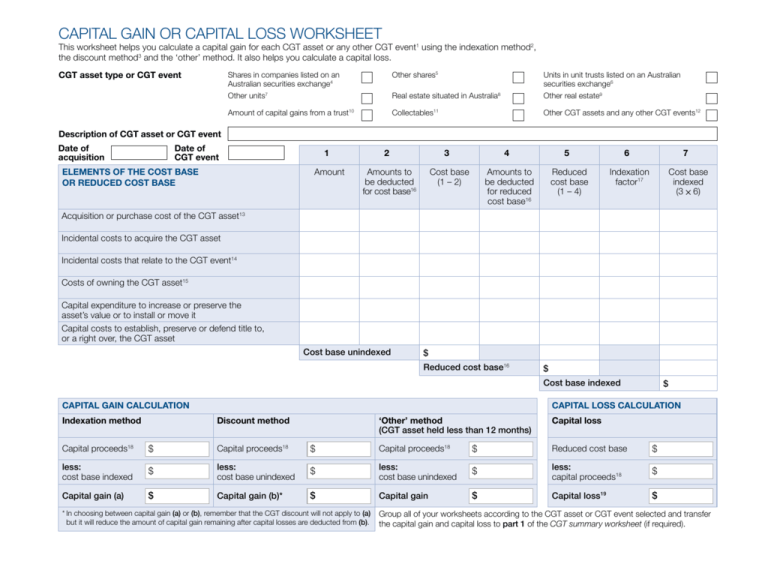
CAPITAL GAIN OR CAPITAL LOSS WORKSHEET This worksheet helps you calculate a capital gain for each CGT asset or any other CGT event1 using the indexation method2, the discount method3 and the ‘other’ method. It also helps you calculate a capital loss. CGT asset type or CGT event Shares in companies listed on an Australian securities exchange4 Other shares5 Units in unit trusts listed on an Australian securities exchange6 Other units7 Real estate situated in Australia8 Other real estate9 Amount of capital gains from a trust10 Collectables11 Other CGT assets and any other CGT events12 Description of CGT asset or CGT event Date of acquisition Date of CGT event ELEMENTS OF THE COST BASE OR REDUCED COST BASE 1 Amount 2 3 Cost base (1 – 2) Amounts to be deducted for cost base16 4 5 6 7 Amounts to be deducted for reduced cost base16 Reduced cost base (1 – 4) Indexation factor17 Cost base indexed (3 6) Acquisition or purchase cost of the CGT asset13 Incidental costs to acquire the CGT asset Incidental costs that relate to the CGT event14 Costs of owning the CGT asset15 Capital expenditure to increase or preserve the asset’s value or to install or move it Capital costs to establish, preserve or defend title to, or a right over, the CGT asset Cost base unindexed $ Reduced cost base16 $ Cost base indexed CAPITAL GAIN CALCULATION Indexation method $ CAPITAL LOSS CALCULATION Discount method ‘Other’ method (CGT asset held less than 12 months) Capital loss Capital proceeds18 $ Capital proceeds18 $ Capital proceeds18 $ Reduced cost base $ less: cost base indexed $ less: cost base unindexed $ less: cost base unindexed $ less: capital proceeds18 $ Capital gain (a) $ Capital gain (b)* $ Capital gain $ Capital loss19 $ *In choosing between capital gain (a) or (b), remember that the CGT discount will not apply to (a) but it will reduce the amount of capital gain remaining after capital losses are deducted from (b). Group all of your worksheets according to the CGT asset or CGT event selected and transfer the capital gain and capital loss to part 1 of the CGT summary worksheet (if required). 1 CGT event You make a capital gain or capital loss if certain events or transactions (called CGT events) happen. Most commonly, CGT events happen to a CGT asset (for example, the disposal of a CGT asset) but some CGT events can happen without involving a CGT asset. For more information about CGT events, see the Guide to capital gains tax 2015. 2 Indexation method* For CGT assets acquired before 11.45am (by legal time in the ACT) on 21 September 1999, the indexation of the cost base of an asset is frozen as at 30 September 1999. Individuals, trusts and superannuation entities can choose to use either the cost base indexed, frozen as at 30 September 1999, or the CGT discount. 3 Discount method* If a CGT event happens to a CGT asset after 11.45am (by legal time in the ACT) on 21 September 1999 and you acquired the asset at least 12 months before the CGT event, you may be entitled to discount the capital gain after applying capital losses. The discount percentage for an individual or trust is 50% and for a complying superannuation entity it is 331/3%. Companies (other than those life insurance companies and friendly societies which carry on life insurance business that are entitled to the CGT discount in respect of their complying superannuation business) are not eligible for the CGT discount. You apply current year capital losses and then unapplied net capital losses from earlier years against current year capital gains before applying the CGT discount. If any capital gains qualify for the CGT small business concessions, you then apply those concessions to each capital gain. 4 Shares in companies listed on an Australian securities exchange Any shares in companies that are listed on an Australian securities exchange. It does not include shares in privately owned companies whereby those shares are not publicly traded. Shares in a privately owned company should be included in ‘Other Shares’. 5 Other shares Any shares that are not listed on an Australian securities exchange, such as privately held shares or shares listed on a foreign securities exchange, but not also on an Australian securities exchange. For example, shares listed on the New York Stock Exchange. 6 Units in unit trusts listed on an Australian securities exchange Any units in a unit trusts listed on an Australian securities exchange. For example, units that are listed on the Australian securities exchange. It does not include units in a private trust, whereby the trust is created for the benefit of one or more ascertainable beneficiaries, and not for the promotion of the welfare of the general public or for the advancement of a cause. However, units in a private trust should be included in Other units label. 7 Other units Any units in a unit trust that are not listed on an Australian securities exchange, such as privately held units or units listed on a foreign securities exchange, but not also on an Australian securities exchange. For example, units listed on the New York Stock Exchange. 8 Real estate situated in Australia Any real property including land and buildings that are situated in Australia. 9 Other real estate Any real estate including land and buildings that are situated outside of Australia. For example, a rental property situated in the United States. 10 Amount of capital gains from a trust (including a managed fund) Distributions from trusts can include different amounts but only the following types of amounts are relevant for CGT purposes: n distributions of all or a part of the trust’s income where the trust’s net income for tax purposes includes a net capital gain, n distributions or other entitlements described as being referable to a specific capital gain or gains and n distributions of non-assessable amounts. For more information on trusts, see Trust distributions. example, disposal of your forestry interests in a forestry managed investment scheme. Note: There are special rules that apply when working out a capital gain or capital loss for a depreciating asset. A capital gain or capital loss will only arise to the extent that you use a depreciating asset for a non-taxable purpose (for example, used privately). You calculate the gain or loss having regard to concepts used in the uniform capital allowance provisions. Those provisions also treat as income or allow as a deduction any gain or loss from a depreciating asset to the extent that you use it for a taxable purpose. 13 Acquisition or purchase cost This is money you paid, property you gave or you are required to pay or give to acquire a CGT asset. The market value of any property you gave, or are required to give, is worked out at the time of acquisition. Modifications and special rules may apply to this element of the cost base, for example, the market value substitution rule. 14 Incidental costs that relate to a CGT event This includes the incidental costs of disposal of a CGT asset or, if there is no disposal of a CGT asset, those incidental costs that relate to the CGT event. 15 Costs of owning the asset Costs of owning the asset include interest on borrowed money, rates and land tax, and the costs of repairing or maintaining the CGT asset. You include them in the cost base provided you acquired the CGT asset after 20 August 1991. These costs cannot be indexed or used to work out a capital loss. You do not include non-capital costs of owning the asset in the cost base of collectables or personal use assets. 16 Cost base and reduced cost base For the cost base, exclude all expenditure recouped or that has been deducted or can be deducted on assets acquired after 7.30pm (by legal time in the ACT) on 13 May 1997. For 11 Collectables assets acquired before this time, exclude all If you acquired a collectable (for example, expenditure recouped, or in respect of incidental jewellery or an antique) for $500 or less, you costs and costs of owning, that have been disregard any capital gain or capital loss. You claimed or can be claimed as a tax deduction. can only use capital losses from collectables In some cases, cost base reductions are to offset capital gains from collectables. This made before indexing (for example, recouped is done in part 2A and 2C of the worksheet. expenditure) and in others, after indexing (for 12 Other CGT assets and any other example, capital works deductions). For the CGT events reduced cost base, exclude any expenditure that Any capital gain or capital loss that you have has been recouped, deducted, can be deducted made that does not fit into any of the categories or is a cost of owning. Indexation does not apply listed in item 1 of the CGT schedule: for to the reduced cost base. 17 Indexation factor Indexation is not relevant to: n expenditure incurred after 11.45am (by legal time in the ACT) on 21 September 1999 relating to a CGT asset acquired before that time, or n expenditure relating to a CGT asset acquired after that time. The cost base includes indexation, frozen as at 30 September 1999, only if you acquired the CGT asset at or before 11.45am (by legal time in the ACT) on 21 September 1999 and have owned it for at least 12 months. There are some exceptions, for example, rollovers and assets inherited from a deceased estate. Indexation is not available for costs of owning the asset and it is not relevant to the reduced cost base. The indexation factor is an amount equal to the consumer price index (CPI) for the quarter of the year in which the CGT event happened to the asset, divided by the CPI for the quarter of the year in which you incurred the expenditure included in any of the cost base elements (except the third element: costs of owning). The indexation factor is taken to three decimal places, rounding up if the fourth decimal place is 5 or more. A list of CPI is at appendix 2. 18 Capital proceeds This is money and the market value of any property that you have received (or are entitled to receive), in respect of the CGT event happening. Modifications and special rules may apply to change the capital proceeds for certain CGT events. If the capital proceeds are greater than the cost base, you make a capital gain. If the capital proceeds are less than the reduced cost base, you make a capital loss. If the capital proceeds are between the cost base, or if applicable the indexed cost base, and the reduced cost base, you make neither a capital gain nor a capital loss. 19 Capital losses You can only use capital losses from collectables to offset capital gains from collectables. You disregard capital losses from personal use assets. You cannot deduct net capital losses from your assessable income. If you became a bankrupt during the year, you disregard unapplied net capital losses from earlier years. *Note: For CGT assets acquired before 11.45am (by legal time in the ACT) on 21 September 1999, you have the option of choosing the CGT discount or calculating the capital gain using indexation frozen at 30 September 1999. Calculate your capital gain under each option to determine the best result in your particular circumstances.

